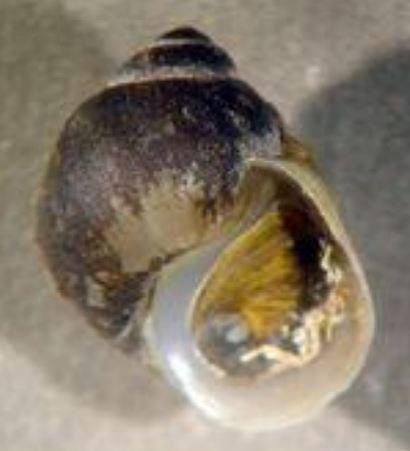The Salmon River pebblesnail population is low in Washington. In the state, this species is only recorded from Asotin County. The species requires clear, cold, well-oxygenated waters, and is threatened by pollution and siltation.
Description and Range
Physical description
The Salmon River pebblesnail is an aquatic snail in the family Lithoglyphidae. Having no lungs or gills, Fluminicola snails respire through the mantle cavity; they have low tolerance for changes to normal levels of oxygen (hypoxia and anoxia). These snails exhibit separate sexes with both male and female individuals.
The Salmon River pebblesnail is a relatively recently described species, closely related to the Olympia pebblesnail (Fluminicola virens).
Members of the Fluminicola genus have relatively large shells.
Ecology and life history
Fluminicola snails are fairly intolerant of impounded waters and soft substrates as well as nutrient-enhanced or lacustrine (lake) habitats. These species are usually found in clear, cold streams with high dissolved oxygen content. They are generally found on hard rocky surfaces where they graze on algae and detritus. They occur under rocks and vegetation in the slow to rapid currents of streams. It is common at the edges of rapids or immediately downstream from whitewater areas, and it becomes much less common or absent in major rapids. In the absence of rapids or whitewater areas, this species is restricted to habitat with sufficient flow, oxygenation, and stable substrate.
Pebblesnails feed by scraping bacteria, diatoms and other perilithic organisms from rock surfaces, and may occasionally feed on aquatic plant surfaces. This species is present all year, but not active in winter. Having no lungs or gills, snails in this genus respire through the mantle cavity, and have low tolerance for hypoxia and anoxia.
The Fluminicola genus exhibits separate sexes with both male and female individuals. Reproduction is by copulation and cross-fertilization, and these species are believed to be semelparous (reproducing only once in a lifetime). Eggs are laid from spring to autumn in gelatinous capsules attached to plants, stones, or other objects.
The individual life span of these species is thought to be approximately one to two years, and population turnover is probably greater than 90 percent. Often, species in this genus appear to be community dominants, comprising most of the invertebrate biomass.
Geographic range
The Salmon River pebblesnail is known only from the Salmon, Clearwater and lower Snake Rivers. In Washington, it is only recorded from Asotin County.
For maps of range-wide distribution and conservation status of this species, check out NatureServe Explorer.
Climate vulnerability
Sensitivity to climate change
There is no information on the sensitivity of this species to climate change.
Exposure to climate change
There is no information on the exposure of this species to climate change.
Conservation
For aquatic snails, limiting factors may include hardness, acidity, dissolved oxygen, salinity, high temperature, and food availability as associated with depth. Snails are uncommon in habitats with surface acidity greater than pH 5. Dissolved oxygen limits diversity, so severely polluted waters (oxygen consumed by algae blooms) are often devoid of freshwater snails excepting pollution-tolerant species. Most species live in the shallows, (depths less than 10 feet) where food abundance is greatest. As a result, drastic water fluctuations (draw-downs) may cause declines in snail populations.
Conservation Threats and Actions Needed
- Fish and wildlife habitat loss or degradation
- Threat: Pollution and siltation.
- Action Needed: Improve water quality of occupied streams.
Resources
References
Applegarth, J. S. 1999. Management Recommendations for Cryptomastix hendersoni, the Columbia Oregonian (land snail) v.20, Section 2, in T. E. Burke, J.S. Applegarth, and T. R. Weasma. Management Recommendations for Survey and Manage Terrestrial Mollusks (v. 2). USFS and BLM.
Burke, T. E. 2013. Land Snails and Slugs of the Pacific Northwest. Oregon State University Press, Corvallis, OR. 344 pp.
Burke, T., J. Applegarth, T. Weasma, and N. Duncan. 1999. Management recommendations for Survey and Manage terrestrial mollusks, ver. 2.0. USDA Forest Service, USDI Bureau of Land Management. Available online at http://www.or.blm.gov/surveyandmanage/MR/TM23Species/m2000-003.htm
COSEWIC. 2013. COSEWIC assessment and status report on the Oregon Forestsnail Allogona townsendiana in Canada. Committee on the Status of Endangered Wildlife in Canada. Ottawa. xii + 87pp. (https://www.canada.ca/en/environment-climate-change/services/species-risk-public-registry.html)
Duncan, N. 2009. Species Fact Sheet: Fluminicola fuscus. U.S. Department of Agriculture, Forest Service, Interagency Special Status/Sensitive Species Program (ISSSSP). (https://www.fs.fed.us/r6/sfpnw/issssp/documents/planning-docs/sfs-ig-fluminicola-fuscus-2009-02.doc (DOC))
Edworthy, A., K. Steensma, H. Zandberg, and P. Lilley. 2012. Dispersal, home range size and habitat use of an endangered land snail, the Oregon Forestsnail (Allogona townsendiana). Canadian Journal of Zoology 90(7):875–884.
Frest, T. J., and E. J. Johannes. 1995. Interior Columbia Basin Mollusk Species of Special Concern. Final Report, Deixis Consultants, Seattle. Prepared for Interior Columbia Basin Ecosystem Management Project, Walla Walla, WA 362 pp.
Jordan, S.F. 2013. Species Fact Sheet: Fluminicola virens. U.S. Department of Agriculture, Forest Service, Interagency Special Status/Sensitive Species Program (ISSSSP) (https://www.fs.fed.us/r6/sfpnw/issssp/documents2/sfs-ig-fluminicola-virens-2013-11.doc (DOC))
Liu, H-P., Marceau D. and R. Hershler. 2016. Taxonomic identity of two amnicolid gastropods of conservation concern in lakes of the Pacific Northwest of the USA. Journal of Molluscan Studies. 82:464-471.
Monthey, R. and N. Duncan 2005. Conservation assessment for Lyogyrus n.sp.2, Masked Duskysnail. USDA Forest Service Region 6, and USDI Bureau of Land Management, Oregon and Washington. (Originally issued in 1998 as management recommendations by R. Monthey; revised 2005 by N. Duncan). 10 pp.
NatureServe. 2015. NatureServe Explorer: An online encyclopedia of life [web application]. Version 7.1. NatureServe, Arlington, Virginia. Available https://explorer.natureserve.org/. (Accessed June 10, 2015).
Steensma, K. M. M., L. P. Lilley, and H. M. Zandberg. 2009. Life history and habitat requirements of the Oregon forestsnail, Allogona townsendiana (Mollusca, Gastropoda, Pulmonata, Polygyridae), in a British Columbia population. Invertebrate Biology 128:232–242.
USFWS. 2011. Endangered and Threatened Wildlife and Plants: 90-day finding on a petition to list 29 mollusk species as threatened or endangered with critical habitat: proposed rule. Federal Register 76 (No. 193, October 5, 2011): 61826-61853.
